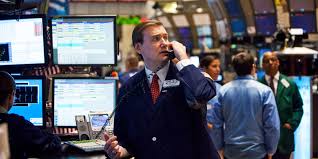Why You Should Care That the 10-Year Treasury Yield Just Reached 3%

The 10-year Treasury yield, a benchmark used to price everything from mortgages to federal student loans, rose to 3% for the first time in four years on Tuesday in part due to fears of rising inflation and expectations of more Fed interest rate hikes this year.
It may be just a number—but it’s a number that is heavily watched. If sustained or pushed higher, it could lead to higher mortgage and business loan interest rates. It could also lead to reduced spending—pushing stocks lower, and forcing investors to rejigger their portfolios after years of ultra-low rates.
Case and point: Partly due to the yields reaching 3% and weaker corporate earnings on Tuesday, the Dow Industrial Average shed 400 points to 24,024 by the market’s close. That drop puts the market 7.5% lower than its peak in January following several days of declines.
“It’s definitely a psychological level we haven’t seen in a while,” says Charlie Ripley, senior investment strategist at Allianz Investment Management. “We haven’t seen 3% since 2014—and even then it was just briefly before we slid into all time lows.”
Adding to the number “3”‘s psychological importance: Famed investors have also pointed to a 3% rate as a turning point. “Bond King” Jeff Gundlach has warned that should the 10-year yield surpass 3%—which it has yet to do—stocks could close lower at the end of 2018. Guggenheim Partners chief investment officer Scott Minerd, meanwhile, warns that rate in excess of 3% signals a bear in the bond market.
Still, bond yields reaching 3% aren’t exactly coming out of nowhere. The Federal Reserve has pointed to raising inflation since the start of the year, while companies including Kimberly-Clark and Whirlpool warned earlier Tuesday of the same trend. It’s hard to think that investors haven’t, to some extent, prepared for higher yields, wrote Ed Yardeni of Yardeni Research.
So it remains to be seen if the effects of the 10-year note reaching 3% on the stock market will be long lasting.
“I think you may see some short term reactions in equity markets,” said PNC Financial Services Group co-chief investment strategist Jeff Mills. “There’s no hard and fast rule that rising rates have to be hard for stocks. The stock market may be just fine.”
The real worry underlying these rising yields, says Mills, is a fear about whether the Fed will raise rates too quickly—helping push treasuries further above 3%.
“There’s definitely potential for a sustained [drop in stocks] if rates run too far too fast, and the Fed tightens too quickly—that could slow down the economy,” Mills said.
What’s also causing some investors worry: A closing spread between the yield of long-term and short-term notes. When the yield on the two-year note exceeds that of the 10-year, it often signals a recession. While the 10-year yield is at about 3% Tuesday, the yield on the two-year note is now at about 2.47%—a difference of roughly 0.5 percentage points. But at the start of the year, that difference was further apart, about 0.6 percentage points.
However, a recession doesn’t look likely, says Greg Valliere of Horizon Investments.
“As the Fed gradually tightens, it will take rates significantly higher than current levels to derail economic growth or the stock market, in our opinion. A recession isn’t remotely imminent, not with the unemployment rate headed below 4%,” he wrote in a note Tuesday.
